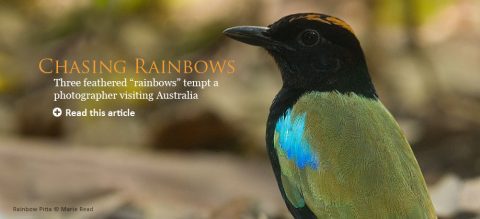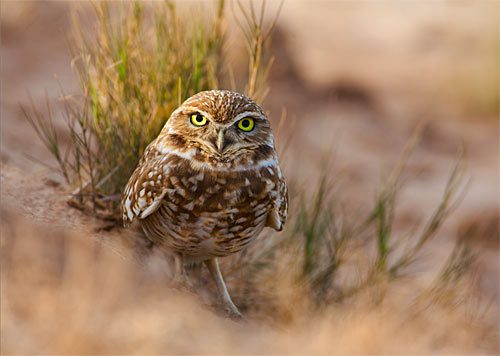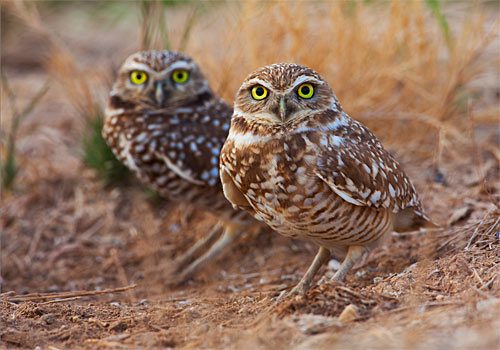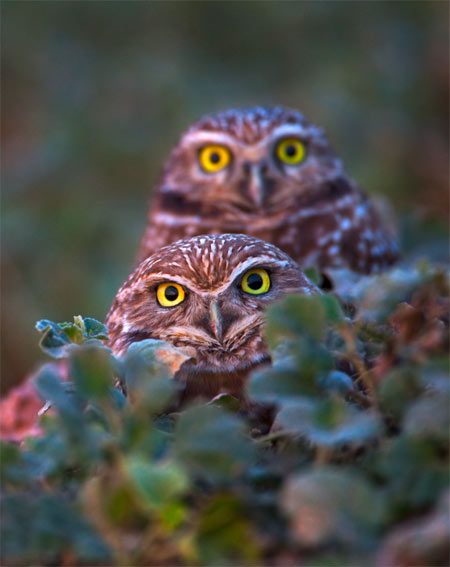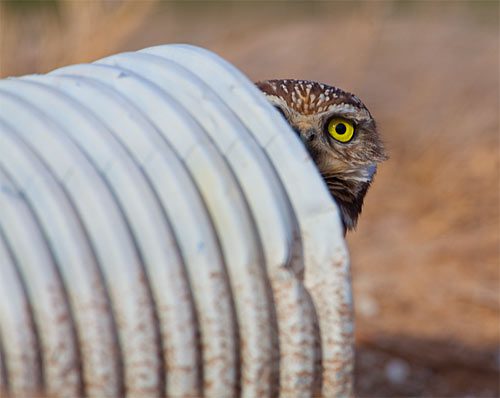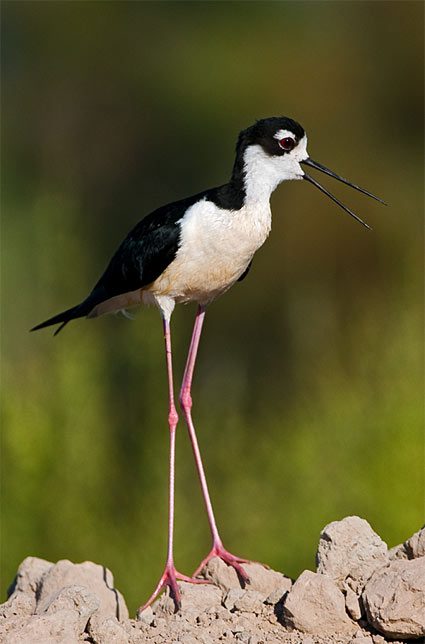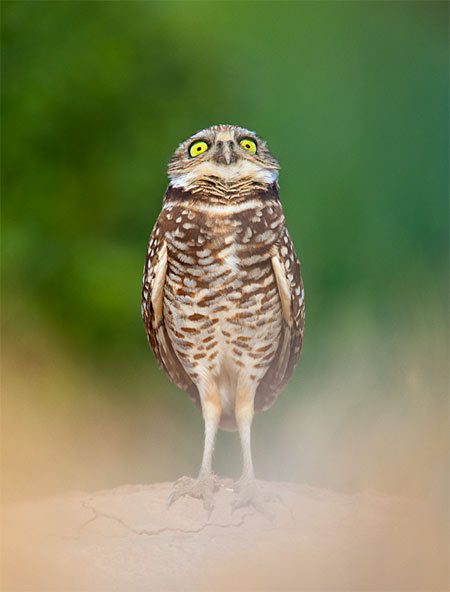The Burrowing Owls of the Salton Sea
by Floris van Breugel
January 15, 2010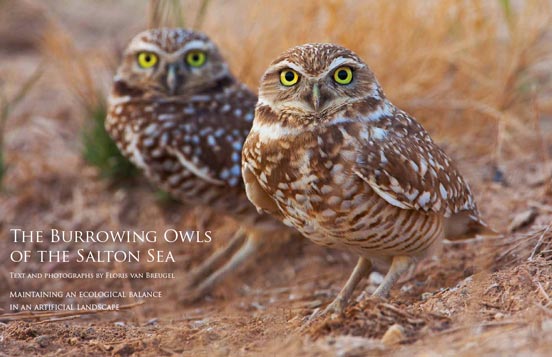
There she stood, poking her head out of the burrow, keeping an eye on me. After a few minutes she crept slowly out and sidled up to her mate to get a better look. Owls are curious creatures—particularly Burrowing Owls, which make their homes in small tunnels in the dry open areas of western North America as well as in Florida, Cuba, and a number of nearby islands. As we stared at each other, we seemed to connect in a way that is difficult with any other kind of bird. Like humans, owls have both eyes in front of their faces, so it seemed like I was photographing two miniature, feathered people. Their behaviors were equally varied, and full of character. The female crouched low to the ground, blending in with the dry grasses and peering at me with her huge yellow eyes, while her mate hopped around on his long skinny legs.
The Burrowing Owl’s scientific name, Athene cunicularia, refers to the Greek deity Athena, goddess of wisdom, who was attended by an owl. Unlike most other owls, this species will hunt throughout the day. Most of their foraging takes place in the early mornings and late evenings, but they will catch anything from grubs to small birds while hanging around outside their burrows during the day. Over time, in addition to wisdom, the goddess Athena also came to symbolize war and the liberal arts, and if any creature can bring all of these characteristics together, it is the owl. Although the diminutive Burrowing Owl might seem to have a rather goofy demeanor compared with larger owls, such as Great Horned and Great Gray owls, they have all the ferocity and stealth of a skilled hunter.
As the sun went down, the pair of owls suddenly took off in complete silence— a feat made possible by their specially evolved feathers. Their primaries are serrated like a comb on the leading edge, which helps break up the flow of air, and the tattered trailing edges of their wings, along with their soft body feathers, further muffle the sound. The fluffy feathers that make them such effective predators also contribute to their cute appearance.
The second part of their name, cunicularia, comes from the Latin word cunicularis, meaning “pertaining to the rabbit.” Although I’m sure a Burrowing Owl would love to eat a tiny young bunny for dinner, the birds probably received the name because they reside in tunnels, like rabbits. Burrowing Owls often nest in colonies, using multiple burrows to increase the chances of their families’ survival in case a predator tries to eat the young. They generally use holes dug by small mammals or tortoises, although they sometimes shape their own holes to some extent. They are very picky when it comes to selecting a nesting location, preferring soft sand and dirt in relatively open areas for good visibility, with an entrance above ground level to avoid flooding.
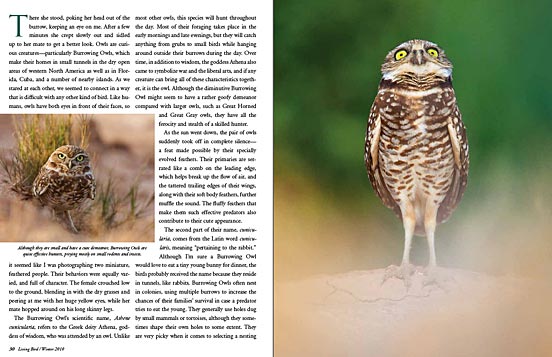
The pair I was photographing, along with several others, was nesting on the fringes of agricultural fields alongside Southern California’s famed Salton Sea, about 80 miles east of San Diego and 30 miles north of the Mexican border. With the expansion of residential and commercial developments over the past few years, the number of burrowing sites and amount of hunting habitat has been decreasing significantly, but the State of California, local farmers, and the nearby Sonny Bono National Wildlife Refuge have been helping the owls by installing artificial plastic burrows. These makeshift homes have been quite successful in such unlikely places as golf courses, airport grasslands, and agricultural fields. The Burrowing Owls make their homes alongside the cement agriculture irrigation ditches there, sometimes no more than three feet from the road. The Salton Sea is now one of the most reliable places to see the tiny owls.
The area is much more than Burrowing Owl habitat; it’s a hotspot for migrating waterfowl along the Pacific Flyway. At first glance, you wouldn’t expect it to be such a great place for birds, with all the agricultural fields, power plants, and hunters. But the area supports one of the most diverse collections of birdlife in the United States, including a number of endangered species.
The story of the Salton Sea’s formation as a wildlife hotspot is ironic. Thousands of years ago, the Gulf of California extended all the way into the Imperial and Coachella valleys, but a natural dam formed, cutting off these valleys from the rest of the gulf. With the high evaporation rate of this desert landscape, the water soon disappeared, leaving behind a salty desert basin. In the early 1900s the Colorado River was diverted to provide water to the Salton Sea basin for agricultural development. Then, in 1905, a structural failure allowed the water to flow freely into the valley for two years. Since then, the water level has been maintained by runoff from the surrounding mountains and countless farms bordering the lake.
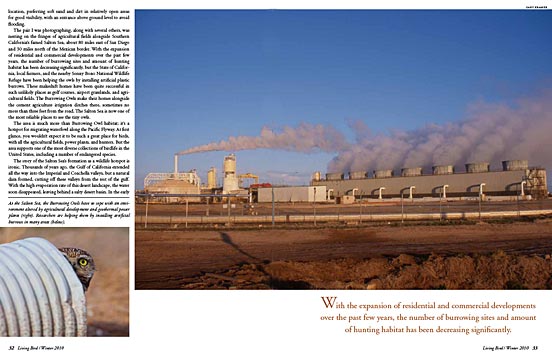
As the water from the Colorado River was diverted, the natural marshlands shrank, and birds began favoring the new marshes appearing at the edges of the young Salton Sea. As farming grew, the vast body of water expanded from the runoff, taking over those marshes and leaving precious little space for the birds. The lake now occupies about 380 square miles, and varies in depth to a maximum of 51 feet. Levees have been installed to prevent further encroachment on the precious marshland between the sea and farms.
The Salton Sea gradually increased in size and salinity, and several marine species were introduced from the Gulf of California. Over the years, the salinity has further increased, and it is now 25 percent saltier than the Pacific Ocean. This has started to threaten the fish species, an important food source for the migrating birds. So what once turned the arid landscape into a haven for thousands of migrating waterfowl is now threatening to destroy that delicate ecosystem. Unless something changes drastically soon, scientists predict that by 2015 all the sport fish will have died off, and many species of birds that nest there will leave shortly after.
While the state is still brainstorming for ideas, some people have started working to make a difference. One such person is Debi Livesay, a former journalist who has been working with the Torres Martinez Tribe to create a wetland for the birds. They started with seven ponds, with a range of depths and up to 20 acres in size, and now the area supports a plentiful collection of plants and fish and numerous species of birds. This is a complicated ecosystem, and it is difficult to predict what will ultimately happen, but this experiment has so far been wildly successful, and she plans to expand the artificial wetlands.
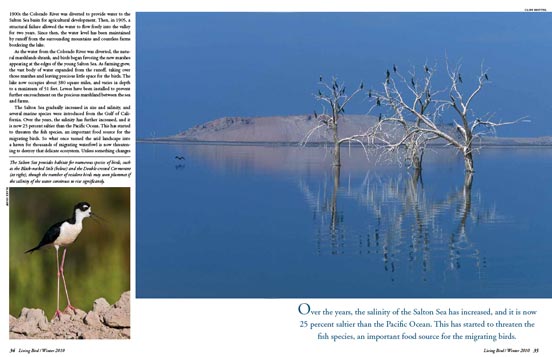
All of these developments directly affect migrating and resident shorebirds, but the entire ecosystem is interconnected. Increased pollution and salinity in the lake will slowly kill off various species in the food chain, and the effects may eventually trickle down to the Burrowing Owls. So far, however, the owls seem to be thriving, largely thanks to efforts on their behalf by the state and by local farmers. The owls prefer to nest under the edges of cement irrigation troughs that line the agricultural fields. The farmers need to keep these areas clear of vegetation to keep the troughs from clogging up, and the owls like these open spaces. Before removing weeds or doing other maintenance work, researchers clearly mark the areas with active burrows and then avoid them to minimize disturbance to the birds.
But nearby commercial and residential development has permanently disrupted many areas with potential burrowing habitat for the birds. To minimize this loss, new state regulations require that every time a burrowing area is destroyed, new artificial burrows must be installed and several acres of foraging space must be set aside. To coax the birds to move into the new areas, artificial burrows are set up before breeding season, and then the birds’ existing burrows are closed off with one-way trap doors. This way the owls can leave but no longer enter their old burrows. Then, over the course of a single night, an entire colony of owls moves to the artificial burrows.
These artificial burrows are simple boxes or wide tubes dug into the ground, with the entrance sticking up in a small mound. They work very well, and many pairs of owls have moved into them. In addition to the artificial burrows installed to replace burrows being destroyed, the wildlife refuge and local farmers have been putting in extra artificial burrows, which is not surprising. These owls benefit farmers, eating many rodents and insects that might otherwise damage crops.
To determine how well these programs are working and to get a better idea of how the owl populations are changing, the Imperial County Water District has been conducting a two-year survey that will finish soon. A statewide survey a few years ago showed a slight decline in Burrowing Owl populations, which corresponds to the trend many photographers had noticed in the Salton Sea area. It is possible, though, that the birds’ population is simply in a natural state of flux. And with all the attention they are getting, many people hope their population will remain stable or even increase.

Although they're small and cute, Burrowing Owls are fierce hunters of rodents and insects. Photo by Floris van Breugel. 
In California's Salton Sea, Burrowing Owls live in an agricultural landscape. Photo by Floris van Breugel. 
A pair of Burrowing Owls stare down the photographer from behind some leafy cover. Photo by Floris van Breugel. 
On agricultural lands, Burrowing Owls often take to culverts instead of earthen burrows. Photo by Floris van Breugel. 
The Black-necked Stilt is another common bird of the Salton Sea. Photo by Floris van Breugel. 
A Burrowing Owl stands to attention at its burrow. Photo by Floris van Breugel.
It is interesting to note that this entire ecosystem was artificial from the beginning. What started out as a desert was accidentally turned into a thriving wildlife sanctuary. Now the area hangs in a delicate balance, both ecologically and politically. These days conservation is a game of compromises, and the Salton Sea area is a balance of desert and oasis, farmland and open spaces, and hunting grounds and wildlife sanctuaries. Ensuring peaceful coexistence among all these interests can be difficult. To keep the geese away from agricultural fields, for example, farmers plant crops in the wildlife refuge during the off season to give the birds something to eat. In adjacent fields, hunters are allowed to shoot waterfowl, and fees from their hunting licenses and waterfowl stamps help fund the wildlife refuge itself.
Another example of ecological and economic balance are the geothermal power plants, operated by the CalEnergy Company, scattered throughout the southern part of the Salton Sea. They provide environmentally sound renewable energy but are another source of habitat destruction and pollution (though far less so than coal-fired power plants).
Despite the unnatural and in many ways depressing landscape, if you get a chance to visit the Salton Sea, I highly recommend it—especially in winter, when countless migratory birds arrive to wait out the cold northern winters. My favorites, the Burrowing Owls, are best seen from December through April. They nest from March through April, and can often be seen posing outside their burrows. During the summer it may be harder to spot them, and the intense desert heat is unpleasant during the day.
As my visit wound to an end, an incredible sunset unfolded overhead. Bright pink light illuminated a landscape that supported the Burrowing Owls, hunters returning from their day’s shoot, countless waterfowl making their home on the lake, and the geothermal power plant churning its turbines to provide renewable power—all surrounded by the agricultural fields growing our food. The moment revealed the importance, and the difficulty, of maintaining a balance among competing interests.
In the fading light, I photographed the owls one last time— huddled together in the low vegetation. They were certainly a happy couple, and I wish them the best of luck on their hunts through the farm fields. Maybe I’ll find their kids next year, posing outside of their own burrows.

All About Birds
is a free resource
Available for everyone,
funded by donors like you
American Kestrel by Blair Dudeck / Macaulay Library
